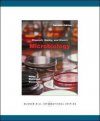Textbook
Out of Print
By: Joanne M Willey(Author), Linda M Sherwood(Author), Christopher J Woolverton(Author)
1088 pages, colour & b/w photos, colour illustrations, colour tables
![Prescott, Harley, and Klein's Microbiology Prescott, Harley, and Klein's Microbiology]()
Click to have a closer look
About this book
Contents
Related titles
Recommended titles
About this book
This edition of Microbiology provides a balanced, comprehensive introduction to all major areas of microbiology. The text is appropriate for students preparing for careers in medicine, dentistry, nursing and allied health, as well as research, teaching and industry.
Contents
Part I: Introduction to Microbiology
1: The History and Scope of Microbiology Ch
2: The Study of Microbial Structure: Microscopy and Specimen Preparation
3: Procaryotic Cell Structure and Function
4: Eucaryotic Cell Structure and Function
Part II: Microbial Nutrition, Growth, and Control
5: Microbial Nutrition
6: Microbial Growth
7: Control of Microorganisms by Physical and Chemical Agents
Part III: Microbial Metabolism
8: Metabolism: Energy, Enzymes, and Regulation
9: Metabolism: Energy Release and Conservation
10: Metabolism: The Use of Energy in Biosynthesis
Part IV: Microbial Molecular Biology and Genetics
11: Microbial Genetics: Gene Structure, Regulation, and Expression
12: Microbial Genetics: Regulation of Gene Expression
13: Microbial Genetics: Mechanisms of Genetic Variation
Part V: DNA Technology and Genomics
14: Recombinant DNA Technology
15: Microbial Genomics
Part VI: The Viruses
16: The Viruses: Introduction and General Characteristics
17: The Viruses: Viruses of Bacteria and Archaea
18: The Viruses: Eucaryotic Viruses and Other Acellular Infectious Agents
Part VII: The Diversity of the Microbial World
19: Microbial Evolution, Taxonomy, and Diversity
20: The Archaea
21: Bacteria: The Deinococci and Nonproteobacteria Gram Negatives
22: Bacteria: The Proteobacteria
23: Bacteria: The Low G + C Gram Positives
24: Bacteria: The High G + C Gram Positives
25: The Protists
26: The Fungi (Eumycota)
Part VIII: Ecology and Symbiosis
27: Biogeochemical Cycling & Introductory Microbial Ecology
28: Microorganisms in Marine and Fresh Water Environments
29: Microorganisms in Terrestrial Environments
30: Microbial Interactions
Part IX: Interaction Between Human Host and Pathogenic Microbes
31: Nonspecific (Innate) Host Resistance
32: Specific (Adaptive) Immunity
33: Pathogenicity of Microorganisms
Part X: Agents of Infectious Disease and Their Control
34: Antimicrobial Chemotherapy
35: Clinical Microbiology and Immunology
36: The Epidemiology of Infectious Disease
37: Human Diseases Caused by Viruses and Prions
38: Human Diseases Caused by Bacteria
39: Human Diseases Caused by Fungi and Protists
Part XI: Food and Industrial Microbiology
40: Microbiology of Food
41: Applied and Industrial Microbiology
Customer Reviews

































